Assessment of Lightning Activity and Early Warning Capability Using Near-Real-Time Monitoring Data in Hanoi, Vietnam
Abstract
1. Introduction
2. Data and Methods
2.1. Data
2.2. Method for Evaluation of Lightning-Stroke Data
2.3. Methodology for Evaluation of Lightning Warning and Performance
3. Results
3.1. Data Evaluation
3.2. Results of Lightning Activity Assessment Using the Strike Guard System
3.3. Results of Lightning Warning Using EFM-100C and Strike Guard Devices
4. Summary and Discussion
Author Contributions
Funding
Institutional Review Board Statement
Informed Consent Statement
Data Availability Statement
Conflicts of Interest
References
- Anh, N.X.; Bazelyan, E.M.; Hieu, N.T.; Loan, D.V.; Huy, L.V.; Thanh, N.T.T.; Ap, T.V.; Nhan, L.D. Investigation of thunderstorm, lightning activities in Vietnam and protective solution recommendation. In The National Project Report; Institute of Geophysics, VAST: Hanoi, Vietnam, 2005; p. 252. (In Vietnamese) [Google Scholar]
- Anh, N.X.; Huy, L.V.; Son, H.H. Some results in thunderstorm and lightning study in Vietnam using lightning detection network. In Proceedings of the 5th Conference Geophysics Scientific, Hochiminh City, Vietnam, 25 August 2007; Science and Technics Publishing House: Hanoi, Vietnam, 2007; pp. 11–20. (In Vietnamese). [Google Scholar]
- Huy, L.V.; Anh, N.X.; Thanh, P.X.; Son, H.H.; Khuong, P.L.; Hop, D.T.B. Study and proposed of the lightning preventive solution in Quangnam. In The Mission Report of the Committee for Local Science and Technology; Institute of Geophysics, VAST: Hanoi, Vietnam, 2013; p. 188. (In Vietnamese) [Google Scholar]
- Duc, N.M. An Overview of Atmospheric Electricity Issues; Vietnam National Committee for the International Geophysics: Hanoi, Vietnam, 1960; p. 135. (In Vietnamese) [Google Scholar]
- Toan, P.N.; Dac, P.T. Vietnam Climate; Science and Technics Publishing House: Hanoi, Vietnam, 1993; p. 312. (In Vietnamese) [Google Scholar]
- Lanh, N.V. Studying the Airmass Thunderstorm Forecast in the Northern Delta in the First Half of Summer. Ph.D. Thesis, Institute of Hydrology and Meteorology, Sofia, Bulgaria, 2001; p. 148. (In Vietnamese). [Google Scholar]
- Ngu, N.D.; Hieu, N.T. Vietnam’s Climate and Climate Resources; Science and Technics Publishing House: Hanoi, Vietnam, 2013; p. 296. (In Vietnamese) [Google Scholar]
- Van Mai, K.; Laurila, T.K.; Hoang, L.P.; Duc Du, T.; Mäkelä, A.; Kiesiläinen, S. Thunderstorm Activity and Extremes in Vietnam for the Period 2015–2019. Climate 2022, 10, 141. [Google Scholar] [CrossRef]
- Amory-Mazaudier, C.; Le Huy, M.; Cohen, Y.; Doumbia, V.; Bourdillon, A.; Fleury, R.; Fontaine, B.; Duyen, C.H.; Kobea, A.; Laroche, P.; et al. Sun-Earth System Interaction studies over Vietnam: An international cooperative project. Ann. Geophys. 2006, 24, 3313–3327. [Google Scholar] [CrossRef]
- Uman, M.A. The Lightning Discharge; Academic Press: Cambridge, MA, USA, 1987; p. 377. [Google Scholar]
- Christian, H.J.; Blakeslee, R.J.; Boccippio, D.J.; Boeck, W.L.; Buechler, D.E.; Driscoll, K.T.; Goodman, S.J.; Hall, J.M.; Koshak, W.J.; Mach, D.M.; et al. Global frequency and distribution of lightning as observed from space by the Optical Transient Detector. J. Geophys. Res. 2003, 108, 4005. [Google Scholar] [CrossRef]
- Cooray, V. The Lightning Flash; The Institution of Engineering and Technology: London, UK, 2008; p. 574. [Google Scholar]
- Uman, M.A. The Art and Science of Lightning Protection; Cambridge University Press: Cambridge, UK, 2008; p. 240. [Google Scholar]
- Albrecht, R.I.; Goodman, S.J.; Buechler, D.E.; Blakeslee, R.J.; Christian, H.J. Where are the lightning hotspots on Earth? Bull. Am. Meteorol. Soc. 2016, 97, 2051–2068. [Google Scholar] [CrossRef]
- Betz, H.D.; Schumann, U.; Laroche, P. Lightning: Principles, Instruments and Applications; Springer: Berlin/Heidelberg, Germany, 2009; p. 641. [Google Scholar]
- Cecil, D.; Buechler, D.; Blakeslee, R. TRMM-LIS climatology of thunderstorm occurrence and conditional lightning flash rates. J. Clim. 2015, 28, 6536–6547. [Google Scholar] [CrossRef]
- Qie, K.; Tian, W.; Wang, W.; Wu, X.; Yuan, T.; Tian, H.; Luo, J.; Zhang, R.; Wang, T. Regional trends of lightning activity in the tropics and subtropics. Atmos. Res. 2020, 242, 104960. [Google Scholar] [CrossRef]
- Qie, K.; Qie, X.; Tian, W. Increasing trend of lightning activity in the South Asia region. Sci. Bull. 2021, 66, 78–84. [Google Scholar] [CrossRef]
- Chronis, T.G.; Goodman, S.J.; Cecil, D.; Buechler, D.; Robertson, F.J.; Pittman, J.; Blakeslee, R.J. Global lightning activity from the ENSO perspective. Geophys. Res. Lett. 2008, 35, L19804. [Google Scholar] [CrossRef]
- Kumar, P.R.; Kamra, A.K. Variability of lightning activity in South/Southeast Asia during 1997–98 and 2002–03 El Nino/La Nina events. Atmos. Res. 2012, 118, 84–102. [Google Scholar] [CrossRef]
- Aranguren, D.; Montanya, J.; Solá, G.; March, V.; Romero, D.; Torres, H. On the lightning hazard warning using electrostatic field: Analysis of summer thunderstorms in Spain. J. Electrost. 2009, 67, 507–512. [Google Scholar] [CrossRef]
- Clulow, A.D.; Strydom, S.; Grant, B.; Savage, M.J.; Everson, C.S. Integration of a Ground-Based Lightning Warning System into a Mining Operation in the Democratic Republic of the Congo. Weather Clim. Soc. 2018, 10, 899–912. [Google Scholar] [CrossRef]
- Mahomed, M.; Clulow, A.D.; Strydom, S.; Mabhaudhi, T.; Savage, M.J. Assessment of a Ground-Based Lightning Detection and Near-Real-Time Warning System in the Rural Community of Swayimane, KwaZulu Natal, South Africa. Weather Clim. Soc. 2021, 13, 605–621. [Google Scholar] [CrossRef]
- Ferro, M.A.d.S.; Yamasaki, J.; Pimentel, D.R.d.M.; Naccarato, K.P.; Saba, M.M.F. Lightning risk warnings based on atmospheric electric field measurements in Brazil. J. Aerosp. Technol. 2011, 3, 301–310. [Google Scholar] [CrossRef]
- Junchi, Z.; Qingfeng, Z.; Shah, A.B.; Xue, J.; Ye, Z. A Lightning Warning Algorithm Using a EFMs Network and LPS. Pak. J. Meteorol. 2015, 12, 49–55. [Google Scholar]
- Montanya, J.; Bergas, J.; Hermoso, B. Electric field measurements at ground level as a basis for lightning hazard warning. J. Electrost. 2004, 60, 241–246. [Google Scholar] [CrossRef]
- Srivastava, A.; Mishra, M.; Kumar, M. Lightning alarm system using stochastic modelling. Nat. Hazards 2015, 75, 1–11. [Google Scholar] [CrossRef]
- Wang, G.; Kim, W.H.; Kil, G.S.; Park, D.W.; Kim, S.W. An Intelligent Lightning Warning System Based on Electromagnetic Field and Neural Network. Energies 2019, 12, 1275. [Google Scholar] [CrossRef]
- Zeng, Q.; Wang, Z.; Guo, F.; Feng, M.; Zhou, S.; Wang, H.; Xu, D. The application of lightning forecasting based on surface electrostatic field observations and radar data. J. Electrost. 2013, 71, 6–13. [Google Scholar] [CrossRef]
- Mkrtchyan, H. Study of Atmospheric Discharges by Near Surface Electric Field Measurements. Open Atmos. Sci. J. 2018, 12, 21–32. [Google Scholar] [CrossRef]
- Li, X.; Yang, L.; Yin, Q.; Yang, Z.; Zhou, F. Lightning Risk Warning Method Using Atmospheric Electric Field Based on EEWT-AS Gand Morpho. Atmosphere 2023, 14, 1002. [Google Scholar] [CrossRef]
- Gremillion, M.S.; Orville, R.E. Thunderstorm Characteristics of Cloud-to-Ground Lightning at the Kennedy Space Center, Florida: A Study of Lightning Initiation Signatures as Indicated by the WSR-88D. Weather Forecast. 1999, 14, 640–649. [Google Scholar] [CrossRef]
- Karagiannidis, A.; Lagouvardos, K.; Kotroni, V. The use of lightning data and Meteosat infrared imagery for the nowcasting of lightning activity. Atmos. Res. 2016, 168, 57–69. [Google Scholar] [CrossRef]
- Mosier, R.M.; Schumacher, C.; Orville, R.E.; Carey, L.D. Radar Nowcasting of Cloud–to–Ground Lightning over Houston, Texas. Weather Forecast. 2011, 26, 199–212. [Google Scholar] [CrossRef]
- Kohn, M.; Galanti, E.; Price, C.; Lagouvardos, K.; Kotroni, V. Nowcasting thunderstorms in the Mediterranean region using lightning data. Atmos. Res. 2011, 100, 489–502. [Google Scholar] [CrossRef]
- Holle, R.L.; Nicholas Demetriades, W.S.; Nag, A. Objective Airport Warnings over Small Areas Using NLDN Cloud and Cloud–to–Ground Lightning Data. Weather Forecast. 2016, 31, 1061–1069. [Google Scholar] [CrossRef]
- Paramanik, M.M.R.; Rabbani, K.M.G.; Imran, A.; Islam, J.; Syed, I.M. Prediction of lightning activity over Bangladesh using diagnostic and explicit lightning parameterizations of WRF model. Nat. Hazards 2024, 120, 4399–4422. [Google Scholar] [CrossRef]
- Rabbani, K.M.G.; Islam, M.J.; Fierro, A.O.; Mansell, E.R.; Paul, P. Lightning forecasting in Bangladesh based on the lightning potential index and the electric potential. Atmos. Res. 2022, 267, 105973. [Google Scholar] [CrossRef]
- Lynn, B.H.; Yair, Y.; Price, C.; Kelman, G.; Clark, A.J. Predicting Cloud-to-Ground and Intracloud Lightning in Weather Forecast Models. Weather Forecast. 2012, 27, 1470–1488. [Google Scholar] [CrossRef]
- Giannaros, T.M.; Kotroni, V.; Lagouvardos, K. Predicting lightning activity in Greece with the Weather Research and Forecasting (WRF) model. Atmos. Res. 2015, 156, 1–13. [Google Scholar] [CrossRef]
- Son, H.H.; Anh, N.X.; Thanh, P.X.; Hiep, N.V. A research on lightning warning by integrated data: A case study for Gialam area, Hanoi city. Vietnam J. Hydrol. 2020, 720, 32–48. (In Vietnamese) [Google Scholar]
- Son, H.H.; Anh, N.X.; Thanh, P.X.; Hiep, N.V. Evaluation of lightning warning technique with multi source data for Vung Tau coastal. Vietnam J. Mar. Sci. Technol. 2023, 23, 209–222. [Google Scholar]
- Son, H.H.; Anh, N.X.; Thanh, P.X.; Khuong, P.L.; Hiep, N.V. Research to improve lightning warning methods based on a combination of multiple data sources applied to some areas in Quang Nam province. Vietnam J. Hydrol. 2024, 766, 29–42. (In Vietnamese) [Google Scholar]
- Wxline, LLC. Strike Guard Lightning Warning System. In User’s Guide; Wxline, LLC: Tucson, AZ, USA, 2012; p. 38. [Google Scholar]
- Boltek Corporation. EFM-100 Atmospheric Electric Field Monitor. In Installation/Operators Guide for Model EFM-100C; Boltek Corporation: Port Colborne, ON, Canada, 2016; p. 50.Monitor. [Google Scholar]
- Chum, J.; Langer, R.; Baše, J.; Kollárik, M.; Strhárský, I.; Diendorfer, G.; Rusz, J. Significant enhancements of secondary cosmic rays and electric field at the high mountain peak of Lomnický Štít in High Tatras during thunderstorms. Earth Planets Space 2020, 72, 28. [Google Scholar] [CrossRef]
- Harrison, R.G.; Nicoll, K.A. Fair weather criteria for atmospheric electricity measurements. J. Atmos. Sol.-Terr. Phys. 2018, 179, 239–250. [Google Scholar] [CrossRef]
- Westcott, N.E. Summertime cloud-to-ground lightning activity around major Midwestern urban areas. J. Appl. Meteorol. 1995, 34, 1633–1642. [Google Scholar] [CrossRef]
- Orville, R.E.; Huffines, G.R.; Nielsen-Gammon, J.; Zhang, R.; Ely, B.; Steiger, S.; Phillips, S.; Allen, S.; Read, W. Enhancement of cloud-to-ground lightning over Houston, Texas. Geophys. Res. Lett. 2001, 28, 2597–2600. [Google Scholar] [CrossRef]
- Feudale, L.; Manzato, A. Cloud-to-ground lightning distribution and its relationship with orography and anthropogenic emissions in the Po Valley. J. Appl. Meteorol. Climatol. 2014, 53, 2651–2670. [Google Scholar] [CrossRef]
- Thornton, J.A.; Virts, K.S.; Holzworth, R.H.; Mitchell, T.P. Lightning enhancement over major oceanic shipping lanes. Geophys. Res. Lett. 2017, 44, 9102–9111. [Google Scholar] [CrossRef]
- Li, Z.; Lau, W.K.-M.; Ramanathan, V.; Wu, G.; Ding, Y.; Manoj, M.G.; Liu, J.; Qian, Y.; Li, J.; Zhou, T. Aerosol and monsoon interactions in Asia. Rev. Geophys. 2016, 54, 866–929. [Google Scholar] [CrossRef]
- Hu, J.; Rosenfeld, D.; Ryzhkov, A.; Zrnic, D.; Williams, E.; Zhang, P.; Snyder, J.C.; Zhang, R.; Weitz, R. Polarimetric radar convective cell tracking reveals large sensitivity of cloud precipitation and electrification properties to CCN. J. Geophys. Res. Atmos. 2019, 124, 12194–12205. [Google Scholar] [CrossRef]
- Sun, M.; Li, Z.; Wang, T.; Mansell, E.R.; Qie, X.; Shan, S.; Liu, D.; Cribb, M. Understanding the Effects of Aerosols on Electrification and Lightning Polarity in an Idealized Supercell Thunderstorm via Model Emulation. J. Geophys. Res. Atmos. 2023, 129, 1–23. [Google Scholar] [CrossRef]
- Shchavlev, A.; Aniskov, I.; Semak, Y.; Markova, I.; Anh, N.X. The concept of an atmospheric observation subsystem in the planetary boundary layer based on a small-sized unmanned aerial platform of an aircraft type with a payload an atmospheric parameter meter. Sci. Innov. Natl. Acad. Sci. Belarus 2025, accepted. (In Russian) [Google Scholar]
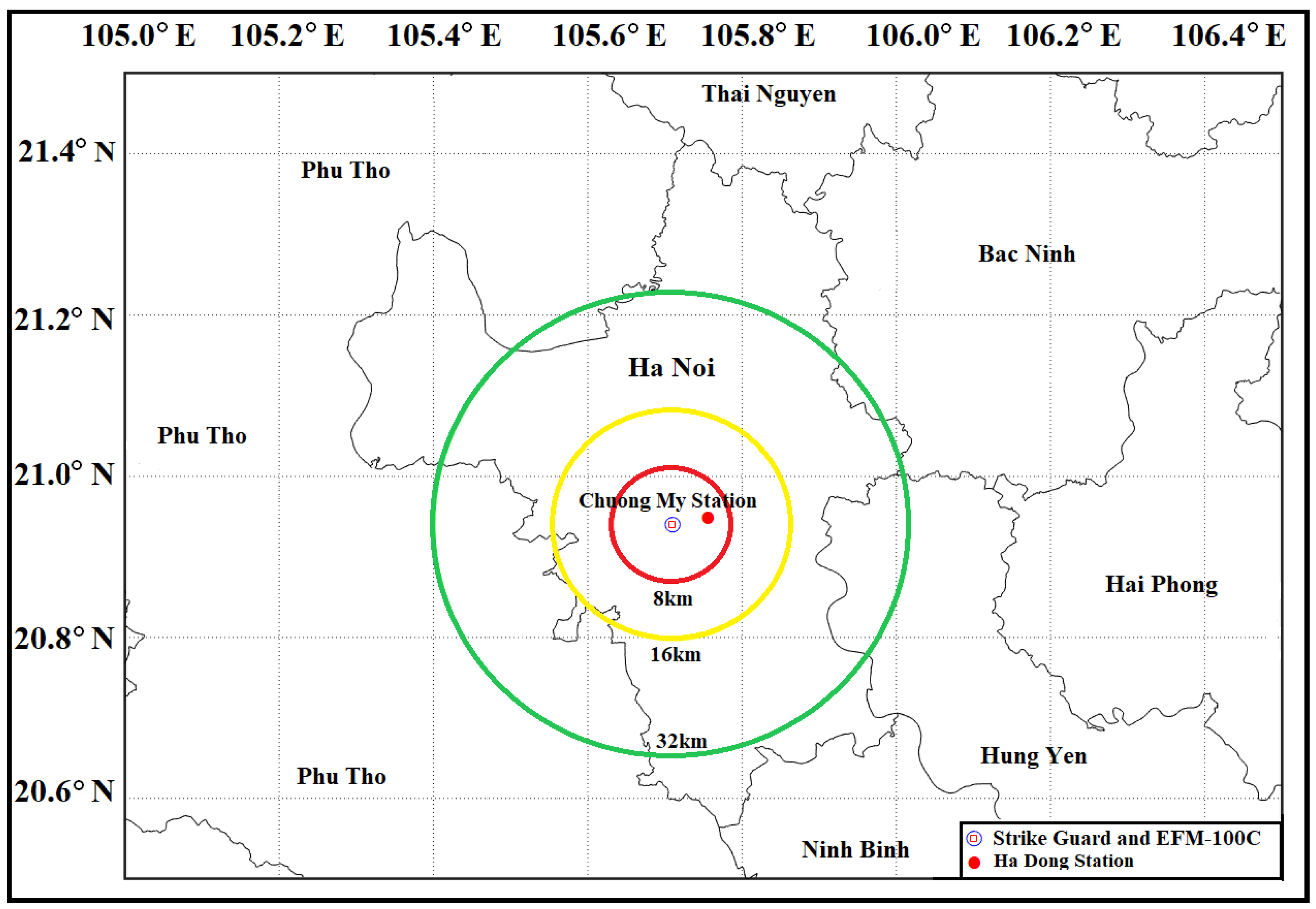



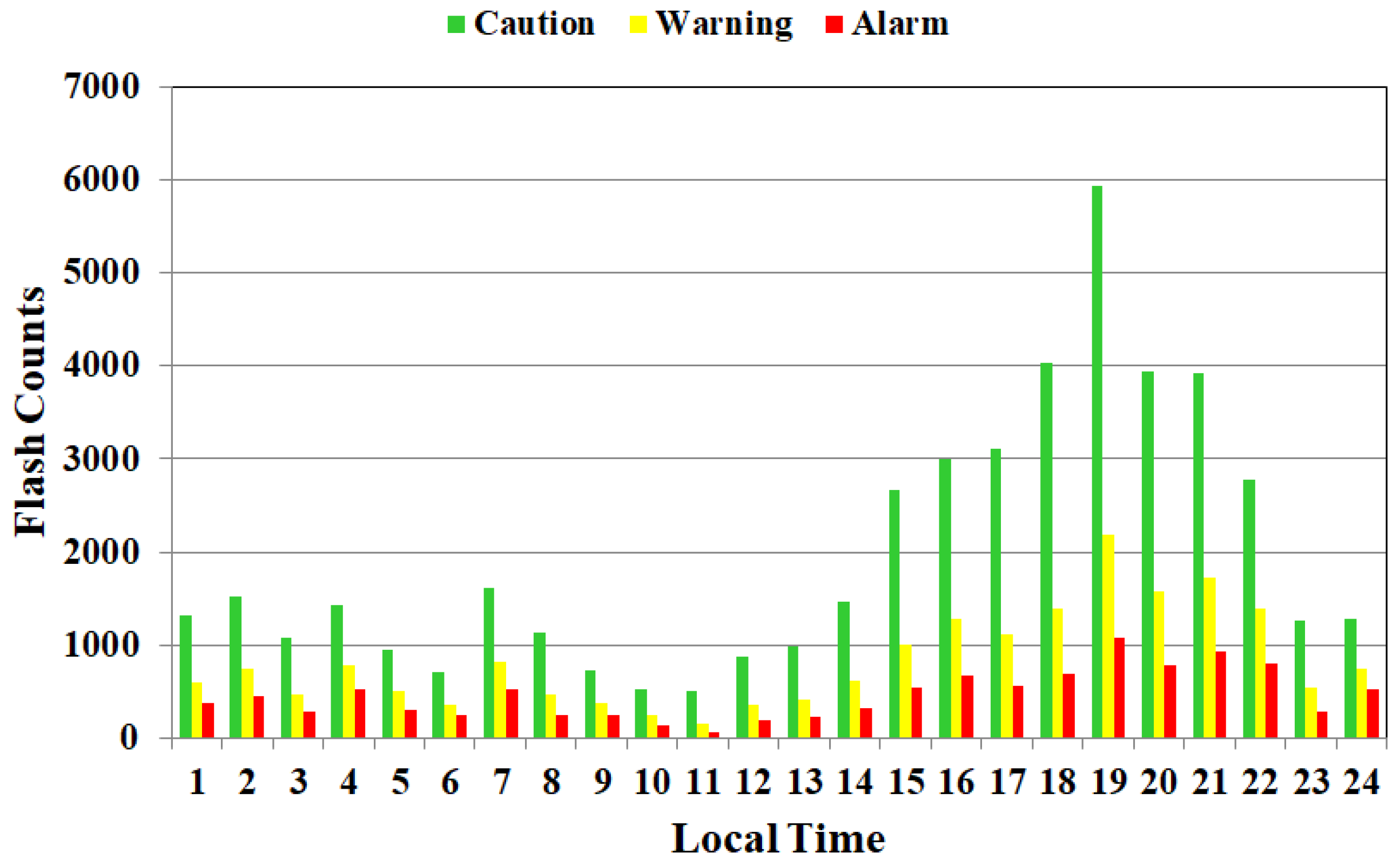
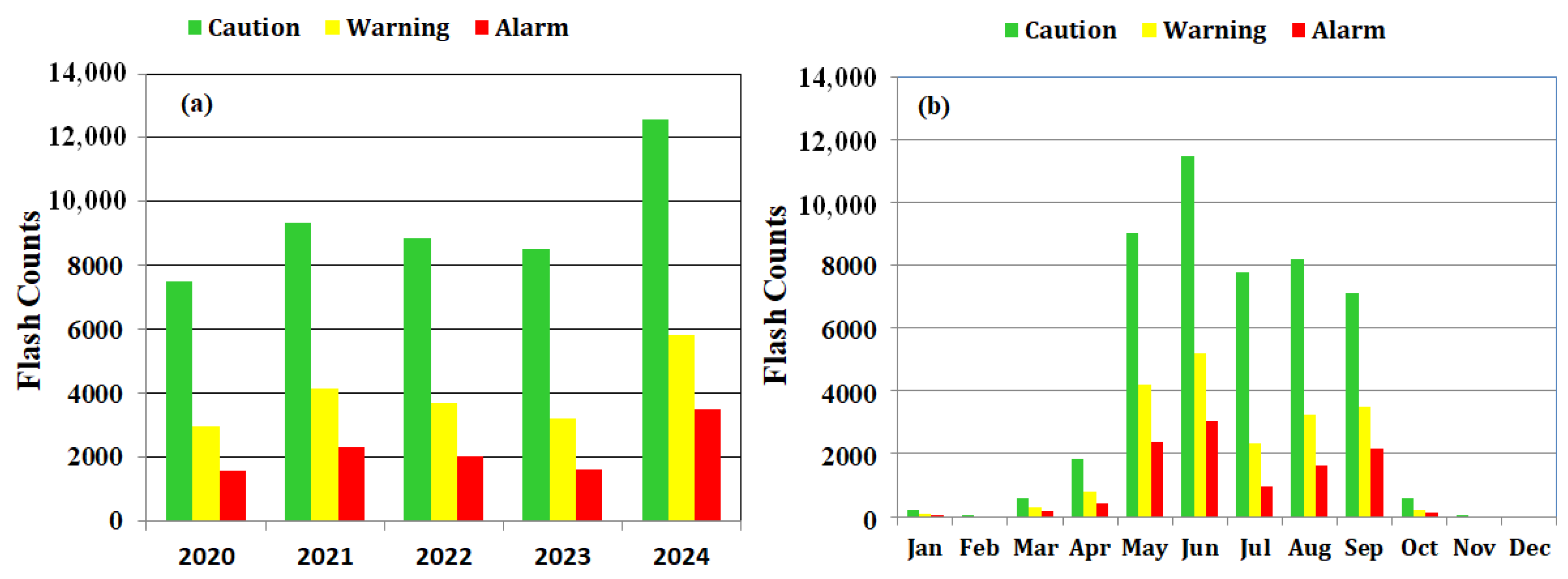



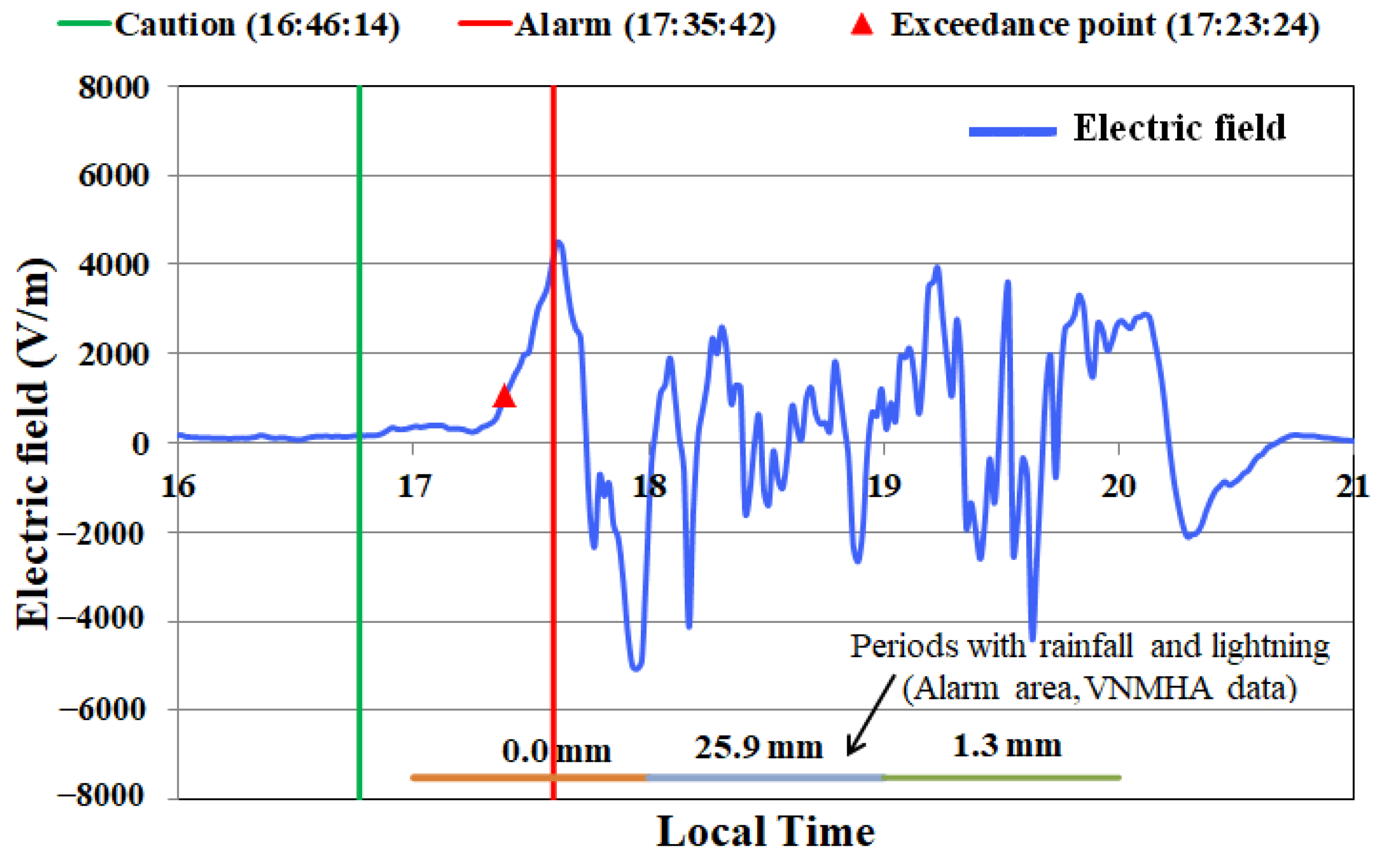
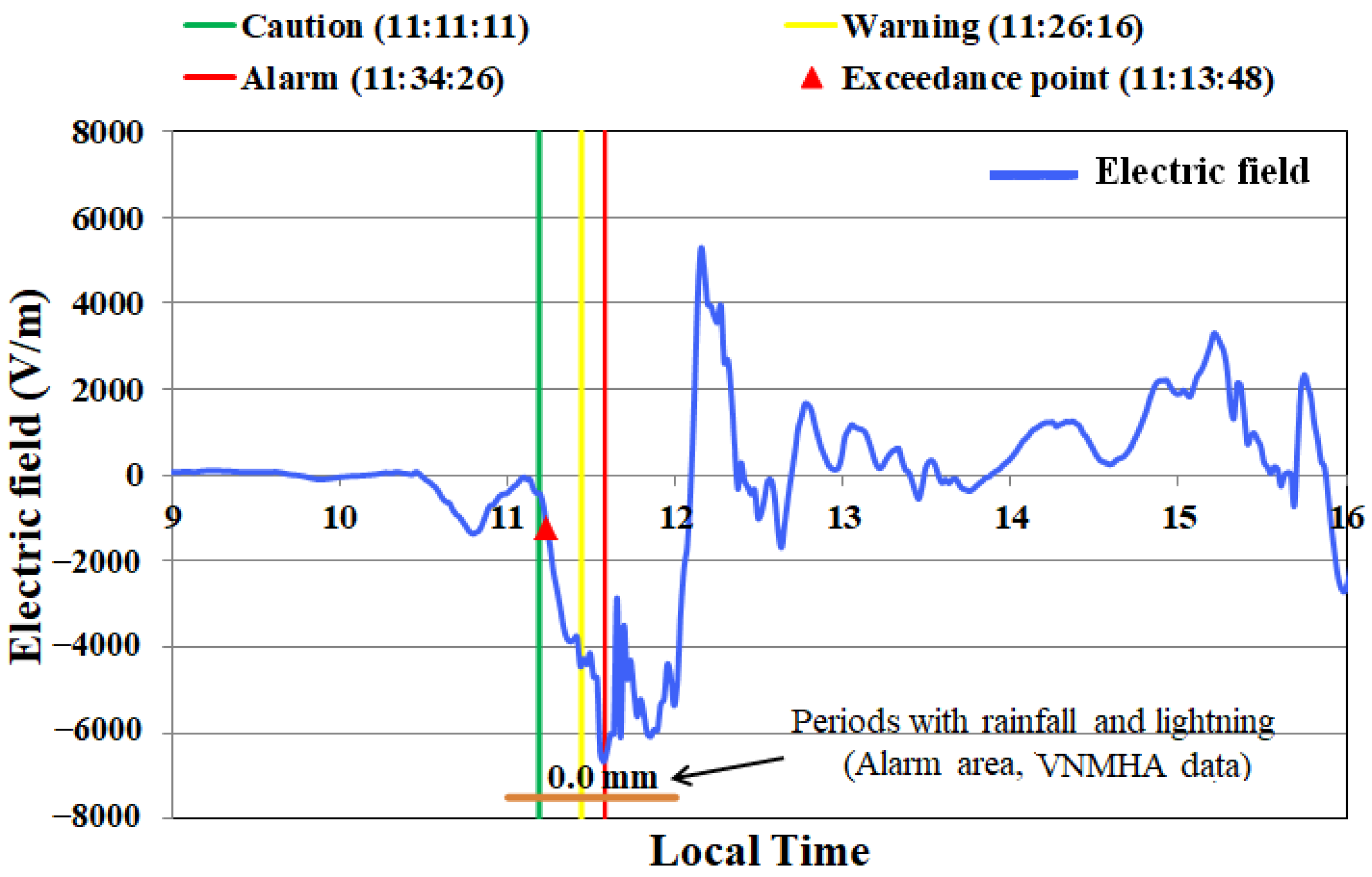
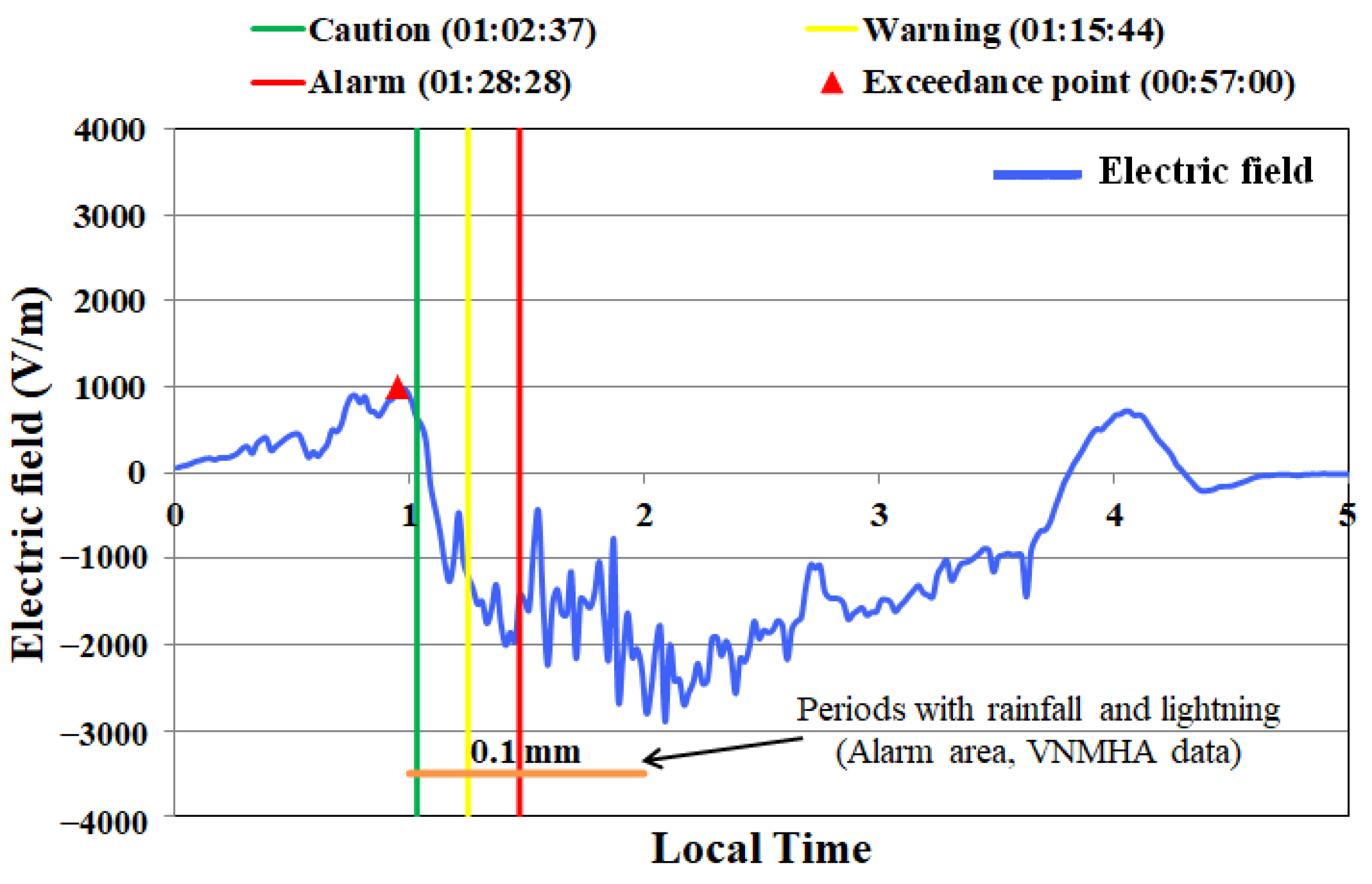

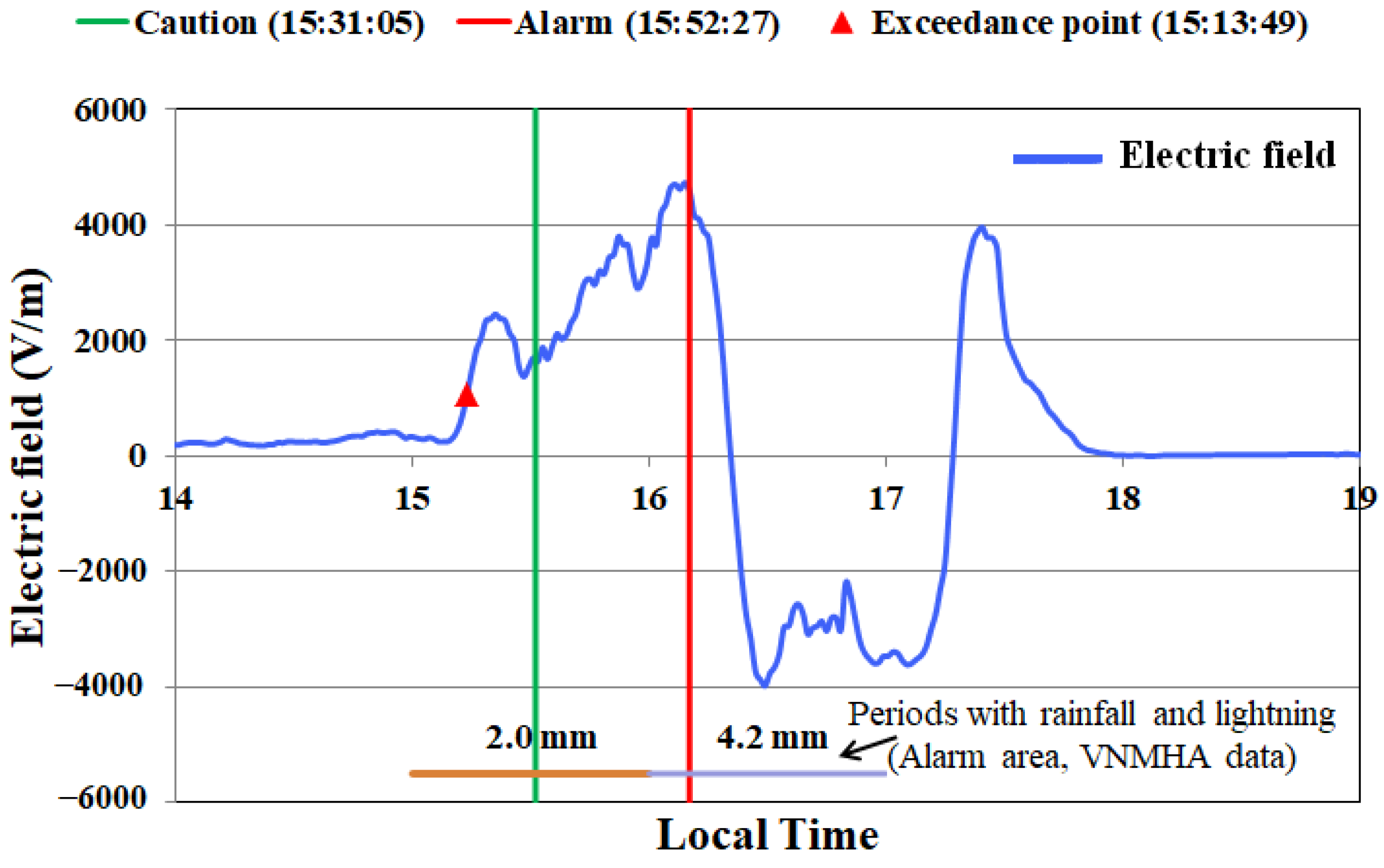


| Station | Longitude | Latitude | Instrument | Data Period |
|---|---|---|---|---|
| Chuong My | 105.7095° E | 20.9386° N | Strike Guard, Wxline LLC, Tucson, Arizona, USA | 2020–2024 |
| Chuong My | 105.7095° E | 20.9386° N | EFM-100C, Boltek, Port Colborne, ON, Canada | 2022–2023 |
| Ha Dong (VNHMA) | 105.7531° E | 20.9569° N | Rain gauge Hyquest Solutions PTY, New South Wales, Australia | 2022–2023 |
| Observations | |||
|---|---|---|---|
| Warning | Yes | No | |
| Yes | A | C | |
| No | B | D | |
| 3000 (V/m) | 2500 (V/m) | 2000 (V/m) | 1500 (V/m) | 1000 (V/m) | 500 (V/m) | |
|---|---|---|---|---|---|---|
| POD (%) | 65.22 | 71.08 | 76.70 | 78.38 | 82.22 | 81.54 |
| FAR (%) | 18.18 | 14.49 | 11.24 | 10.31 | 8.26 | 8.62 |
| CSI (%) | 56.96 | 63.44 | 69.91 | 71.90 | 76.55 | 75.71 |
| Pre (%) | 81.82 | 85.51 | 88.76 | 89.69 | 91.74 | 91.38 |
| F1 (%) | 72.58 | 77.6 | 82.29 | 83.7 | 86.72 | 86.2 |
Disclaimer/Publisher’s Note: The statements, opinions and data contained in all publications are solely those of the individual author(s) and contributor(s) and not of MDPI and/or the editor(s). MDPI and/or the editor(s) disclaim responsibility for any injury to people or property resulting from any ideas, methods, instructions or products referred to in the content. |
© 2025 by the authors. Licensee MDPI, Basel, Switzerland. This article is an open access article distributed under the terms and conditions of the Creative Commons Attribution (CC BY) license (https://creativecommons.org/licenses/by/4.0/).
Share and Cite
Son, H.H.; Anh, N.X.; Thai, T.H.; Thanh, P.X.; Khuong, P.L.; Nguyen, H.V.; Thuy, D.N.; Minh, B.N.; Vinh, N.N.; Ve, D.Q.; et al. Assessment of Lightning Activity and Early Warning Capability Using Near-Real-Time Monitoring Data in Hanoi, Vietnam. Atmosphere 2025, 16, 1335. https://doi.org/10.3390/atmos16121335
Son HH, Anh NX, Thai TH, Thanh PX, Khuong PL, Nguyen HV, Thuy DN, Minh BN, Vinh NN, Ve DQ, et al. Assessment of Lightning Activity and Early Warning Capability Using Near-Real-Time Monitoring Data in Hanoi, Vietnam. Atmosphere. 2025; 16(12):1335. https://doi.org/10.3390/atmos16121335
Chicago/Turabian StyleSon, Hoang Hai, Nguyen Xuan Anh, Tran Hong Thai, Pham Xuan Thanh, Pham Le Khuong, Hiep Van Nguyen, Do Ngoc Thuy, Bui Ngoc Minh, Nguyen Nhu Vinh, Duong Quang Ve, and et al. 2025. "Assessment of Lightning Activity and Early Warning Capability Using Near-Real-Time Monitoring Data in Hanoi, Vietnam" Atmosphere 16, no. 12: 1335. https://doi.org/10.3390/atmos16121335
APA StyleSon, H. H., Anh, N. X., Thai, T. H., Thanh, P. X., Khuong, P. L., Nguyen, H. V., Thuy, D. N., Minh, B. N., Vinh, N. N., Ve, D. Q., Mai Khanh, H., Quan, D. D., & Du Duc, T. (2025). Assessment of Lightning Activity and Early Warning Capability Using Near-Real-Time Monitoring Data in Hanoi, Vietnam. Atmosphere, 16(12), 1335. https://doi.org/10.3390/atmos16121335






